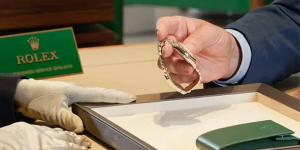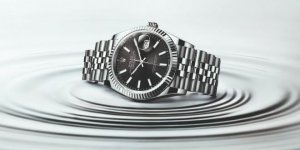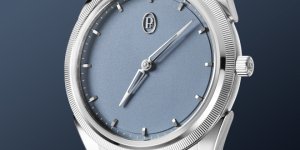Rolex’s Mission for Hope: Conservancy in the Galápagos Islands
With Rolex’s support, Mission Blue conducted a two-week research expedition across the Galápagos Islands to gather crucial data for conservancy efforts
The Galápagos Islands and their waters are amongst the most biodiverse regions in the world. The environment is also home to an unusually large number of endemic species, due to the remote location in the Pacific Ocean, some 900 km from continental Ecuador’s west coast. This unique set of qualities has made the Galápagos an especially important focus of ocean conservation efforts.
Indeed, much has been accomplished. The Ecuadorian government, for instance, established the Galápagos Marine Reserve to protect the islands’ waters in 1998, then expanded the reserve’s coverage by approximately 50 per cent in 2021 to its present size of 133,000 km2. Ocean conservation non-profit Mission Blue, founded by the famed marine biologist and Rolex Testimonee Sylvia Earle, also designated the waters of the Galápagos as one of its first “Hope Spots” in 2010.
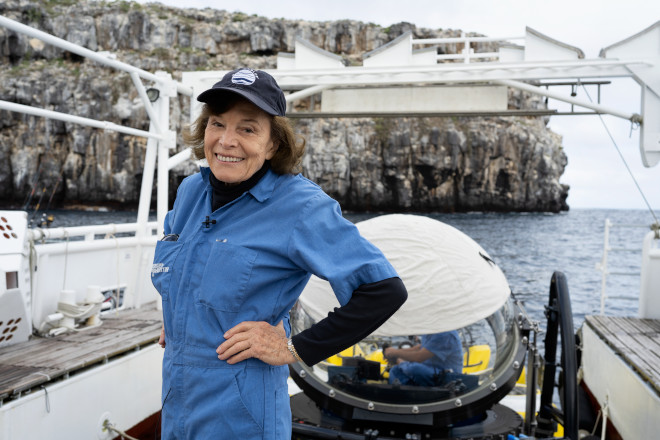
Sylvia Earle, Rolex Testimonee and founder of Mission Blue, in front of the DeepSea submersible. In 2022, she led an expedition to the Galápagos Islands Hope Spot.
Far from being a one and done process, ocean conservation is an ongoing endeavour. To that end, Earle led a multi-institutional team of scientists on a two-week research expedition across the Galápagos Islands Hope Spot in 2022. Conducted with Rolex’s support, the Mission Blue Galápagos expedition worked to assess the impact of the existing protections that are in place, as well as to identify the challenges and opportunities for future conservation efforts.
IMPACT STUDY
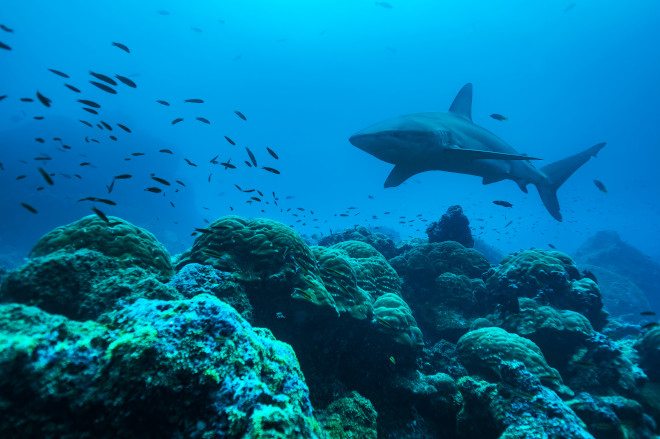
A Galápagos shark patrols the reefs of the Galápagos Islands Hope Spot.
Earle, a Rolex Testimonee since 1982, is a veteran marine biologist and oceanographer with over six decades of experience in these fields. Her first visit to the Galápagos took place in 1966, when she discovered its waters teeming with life and remarked that they were “the sharkiest, fishiest place” she had ever been. Since then, the wider awareness of the volcanic archipelago has grown exponentially. Unfortunately, this has resulted in greater pressures on the delicate ecosystems of the Galápagos, whether from pollution, invasive species, or demands on its resources. Protecting the region is thus more critical than ever before.
A large part of the expedition was devoted to revealing the hidden and forgotten diversity beneath the waves to provide a baseline value of ecosystem health that can be tracked by future surveys. To do so, the expedition employed a range of cutting-edge technologies such as underwater video systems, which allowed the expedition team to collect population data for little-studied animals such as endemic slipper lobsters.
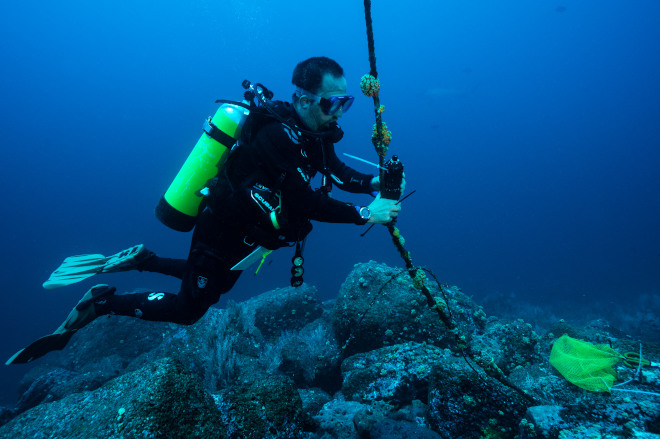
Alex Hearn, Mission Blue co-Champion for the Galápagos Islands Hope Spot and Professor of Marine Biology at Universidad San Francisco de Quito, retrieves and replaces a receiver that has been detecting tagged marine animals passing by.
To complement the above, eDNA (environmental DNA) analysis was also used. The technique involves isolating and sequencing DNA found in the environment being studied, in this case via seawater samples. The crucial advantage here is that data on organisms that elude visual study can still be gathered. Unsurprisingly, eDNA analysis did turn up interesting results. “Most of our sequences are not matching any public database,” shared Diana Pazmiño, a researcher with the Galápagos Science Center. “[This] means that not many things have been sequenced from the Galápagos, or there are things that are new to science that we have not identified yet.”
This finding paralleled an earlier expedition undertaken by Earle and Salome Buglass of the Charles Darwin Foundation, which took place the year before. During that study, a new species of kelp was discovered deep beneath the water’s surface. The two scientists followed up on the discovery on the 2022 expedition by exploring the Galápagos’ depths in the DeepSee submersible, where they uncovered lush hidden forests of kelp. There are now tentative theories that these kelp forests are critical in maintaining the region’s biodiversity. “Kelp forests in other parts of the world have a critical role in supporting biodiversity,” explained Buglass, “and maybe we have found that piece of the puzzle that explains why biodiversity and biomass are so amazingly rich in the Galápagos.”
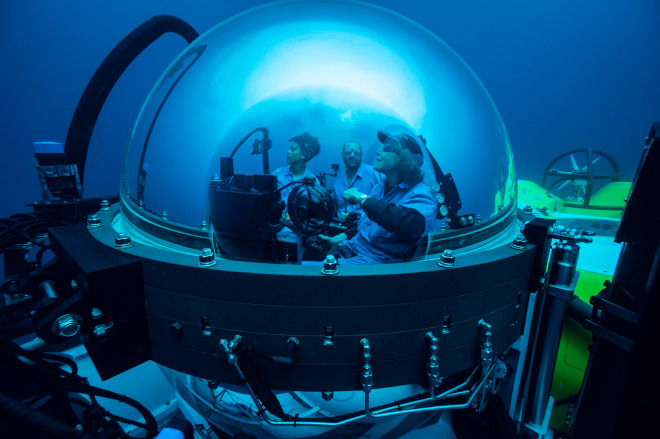
Sylvia Earle and Salome Buglass descend in the DeepSee submersible in search of deep sea kelp that may be new to science, during the Mission Blue Galápagos expedition in 2022.
Various other broad-based studies were also undertaken during the 2022 expedition, from mapping the foraging grounds of penguin colonies to measuring microplastic levels. The expedition team continued ongoing long-term research into the transoceanic movements of marine animals too by, for example, capturing location tags of sharks that have come from as far away as the Gulf of Mexico. This is particularly important, as it supports the view that international cooperation is vital to ocean conservation work – as well as the need to expand marine protections further. In 2021, Ecuador, Panama, Colombia, and Costa Rica jointly announced the creation of the Eastern Tropical Pacific Marine Corridor, which expanded and linked the four countries’ protected waters to create a fishing-free “swimway” for migratory sharks, turtles, rays and whales. The expedition’s findings have demonstrated the need for more such swimways – globally, no less – to protect marine wildlife, and the need to think on a larger scale beyond national borders.
A MODEL TO FOLLOW
In many ways, the Galápagos Islands Hope Spot is a bellwether for ocean conservancy as a whole. On one level, the attention and support that the islands receive mean that the region has, arguably, the greatest chance of success in this area. As Earle herself has succinctly asked, “If you can’t protect the Galápagos Islands, what part of the planet can you protect?”
On another level, the work that is being done in the region also has the potential to serve as the model for conservancy projects elsewhere to follow. Alex Hearn, an ecologist from the Galápagos Science Center who convened the team of scientists for the expedition, believes that “if we can get it right here [in the Galápagos], that is a blueprint for getting it right across the planet.” From best practices in monitoring the markers of an ecosystem’s health to cross-disciplinary approaches for reversing human impacts on the environment, the Galápagos Islands Hope Spot is serving as a pioneer in the field, with lessons learned from its management percolating to other Hope Spots – and beyond.
THE BIGGER PICTURE
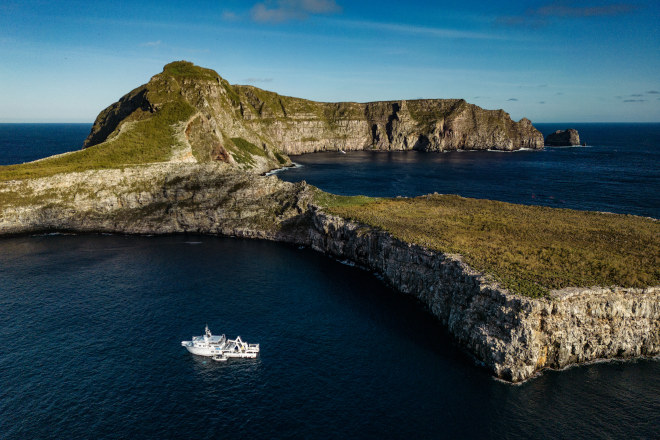
Argo, a state-of-the-art research vessel, is moored off of Wolf Island during the Mission Blue Galápagos expedition in 2022, led by legendary oceanographer Sylvia Earle, Rolex Testimonee and founder of Mission Blue.
Mission Blue will, of course, continue to establish Hope Spots around the world to protect oceanic regions of significant value. Since its founding in 2009 by Earle, the organisation has already created a network of 150 Hope Spots covering nearly 58 million km2 of the oceans. The goal is to extend this protection to 30 per cent of the oceans by 2030.
Rolex’s support for Mission Blue is part of its overall commitment to protecting the planet. This is an extension of its work in championing exploration – both for the sake of discovery and to push the limits of human endeavour. The brand subsumed its efforts in this area under the Perpetual Planet Initiative in 2019, and currently counts Mission Blue and the National Geographic Society as its major partners. As part of its expanding portfolio of partnerships under the initiative, Rolex also supports diverse projects such as Steve Boyes’s the Great Spine of Africa expeditions, which explores the continent’s major river basins, as well as Coral Gardeners’s work to transplant resilient corals to rejuvenate reefs.
Rolex’s commitment to supporting the individuals and organisations using science to understand and overcome our environmental challenges is long-term. In much the same way, this parallels the manufacture’s approach to watchmaking, which sees it taking the long view on things with a focus on constant improvements in every possible area. Given time, the right resources, and a little luck, the challenges that our planet faces may be overcome yet.




